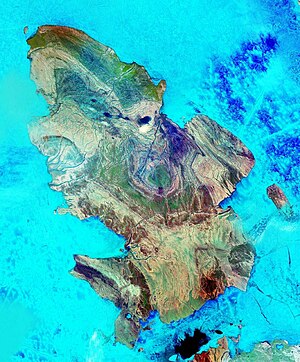Amund Ringnes Island
| Amund Ringnes Island | |
|---|---|
| Amund Ringnes Island satellite image | |
| Waters | Arctic Ocean |
| Archipelago | Sverdrup Islands ( Queen Elizabeth Islands ) |
| Geographical location | 78 ° 16 ′ N , 96 ° 38 ′ W |
| length | 119 km |
| width | 75 km |
| surface | 5 255 km² |
| Highest elevation | (unnamed) 265 m |
| Residents | uninhabited |
Amund Ringnes Island is an island in the Canadian territory of Nunavut and belongs to the Sverdrup Islands , which in turn are part of the Queen Elizabeth Islands .
geography
The island is east of Ellef Ringnes Island , separated by Hassel Sound , west of Axel Heiberg Island , separated by Massey Sound and north of Cornwall Island , separated by Hendriksen Strait . Haig-Thomas Island is upstream in Massey Sound . Amund Ringnes Island has an area of 5,255 km². Most of the island is very flat with heights of less than 100 m. Between Cape Sverre in the north and Cape Ludwig in the south, the island is 119 km long. Their maximum width is 75 km.
Amund Ringnes Island consists mostly of shale and limestone with dykes and dikes of labradorite and other igneous minerals . In the north there is a 30 km long gypsum - evaporite , which with 265 meters above sea level, the highest altitude reached the island.
history
Participants in the Second Fram Expedition (1898–1902) sighted Amund Ringnes Island for the first time on April 16, 1900 from the west coast of Axel Heiberg Island. Otto Sverdrup then sent Gunnerius Ingvald Isachsen and Sverre Hassel across the Massey Sound, who entered the island on April 20th and took possession of it for Norway. Sverdrup named it after Amund Ringnes , a co-founder of the Norwegian brewery Ringnes , which co-financed the expedition. The following year, Isachsen mapped parts of the island when he circled Amund Ringnes and Ellef Ringnes with Hassel.
On June 15, 1908, on his way back from his attempt to reach the North Pole , Frederick Cook met again for the first time at Cape Sverre. He stepped onto the little nameless island west of the cape, unofficially called Cook Island, and continued south through Hassel Sound.
In 1916 Donald MacMillan (1874–1970) came to the south coast of the island, and a month later Vilhjálmur Stefánsson , coming from Meighen Island , passed the west coast without going ashore. It was not re-entered until 1929 by a patrol of the Royal Canadian Mounted Police . In 1930 Hans Krüger's expedition disappeared in the area of the Sverdrup Islands. Kruger last message found on Meighen Island states Cape Sverre as the next destination. It is still unclear whether Krüger ever got there. No traces of the expedition have yet been found on the island.
In 1938 the British ornithologist David Haig-Thomas (1908–1944) paid a brief visit to Amund Ringnes Island and discovered the island named after him. A complete mapping of the island from Amund Ringnes Island was not made until 1955 by the Geological Survey of Canada . The island has been the subject of intense exploration by oil companies since the 1970s .
Individual evidence
- ↑ The Atlas of Canada - Sea Islands ( Memento from October 6, 2012 in the Internet Archive ) (English)
- ↑ a b Ted Heckathorn: Amund Ringnes Iceland . In: Mark Nuttall (Ed.): Encyclopedia of the Arctic . tape 1 . Routledge, New York and London 2003, ISBN 1-57958-436-5 , pp. 82–83 (English, limited preview in Google Book Search).
- ↑ Belcher Channel . Natural Resources Canada map at a scale of 1: 1,000,000
- ^ Robert W. Park, Douglas R. Stenton: A Hans Krüger Arctic Expedition Cache on Axel Heiberg Island, Nunavut . In: Arctic . tape 60 , no. 1 , 2007, p. 1–6 (English, article online [PDF; 2.7 MB ; accessed on January 22, 2017]).
- ^ British Arctic Expedition, 1937-38 . In: Polar Record . tape 17 , 1939, pp. 48–50 (English, article online [PDF; 15.8 MB ; accessed on January 22, 2017]).
- ^ William James Mills: Exploring Polar Frontiers - A Historical Encyclopedia . tape 1 . ABC-CLIO, 2003, ISBN 1-57607-422-6 , pp. 13 (English, limited preview in Google Book search).

